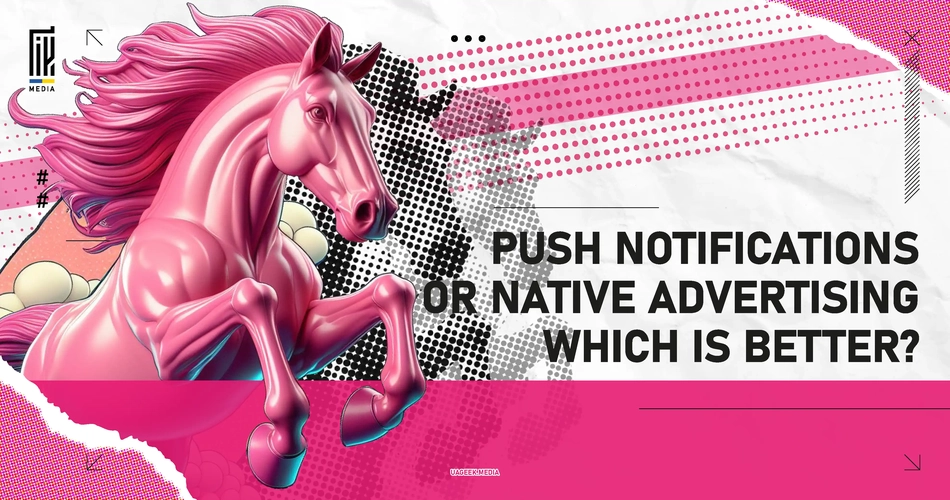Welcome, community! The first thing to choose before starting a campaign is the format through which you will promote the offer. Sometimes this option is dictated by the conditions set by the advertiser. But there are many examples where the advertiser pays for almost any traffic that you bring to their product. This sounds good, but it raises even more questions about which format will be most appropriate.
Today, we’ll compare push notifications with native advertising. We’ll discuss which of these formats is better to use in certain situations and their advantages and disadvantages – all in our new review.
Before we start, remember that we always prepare great reviews for you. In addition to native advertising and push notifications, we have also discussed Discord as a traffic source. So, we recommend checking it out!
What is Native Advertising?
Native advertising is a format of advertising that blends organically into the main content. It exists in many variations: from a banner in the middle of a website text to a branded jacket on an influencer.
Unlike push notifications, which we will talk about later, native advertising allows for experimentation with formats. Accordingly, an affiliate has the opportunity to test various combinations until they find the right one.
Native advertising has the following advantages:
- It enhances brand recognition, and the recipient does not feel aversion to such advertising because, by concept, it should blend seamlessly into the main content;
- Native advertising is equally beneficial not only for the advertiser but also for the publisher. The latter can complement the content by referring to a thematic product. Meanwhile, the advertiser receives targeted traffic that can increase conversion;
- Native advertising cannot be blocked. If it’s advertising in a video, it cannot be skipped by an app. If it’s a banner, it disguises as an image in an article, for example, and any AdBlock is unlikely to react to it;
- There are countless sources of native traffic, and access to it is extremely simple. The main thing is to find a quality platform from which you will be pouring native traffic. However, you will definitely not have problems with this.
However, one issue that may arise is the budget. Because native traffic is one of the most expensive on the market, obviously if you buy it on a large platform. And this is perhaps the main disadvantage of this type of advertising.
But keep in mind that for this money we are buying the cleanest traffic, for which any advertiser will pay. And if you are also pouring from a platform relevant to the offer, this will also ensure you a high conversion.
What are Push Notifications?
In light of native advertising, it might seem that other advertising formats are completely unnecessary. However, their lower cost means that push notifications are still in fairly high demand.
Push notifications are generally any messages that pop up on the user’s browser or smartphone. A notification about receiving a message in a messenger is also a push.
Today, push notifications have long been used for promoting offers. Users receive pop-up messages containing advertisements. But for this, they must subscribe to it, which sometimes poses problems.
But to be fair, we should also note that push notifications can also be considered a relatively native format. Just in terms of how they look on paper. Just like branded items on an influencer, push notifications also disguise as ordinary notifications, which can contribute to a high CTR, at a minimum.
Among the advantages of push notifications, we can highlight:
- Low cost. Push notifications are one of the most wallet-friendly formats, so they can be used in many combinations just for testing, and you won’t go broke;
- Push notifications can be applied in various verticals, they provide more or less similar conversion. They are most relevant when working with financial offers, installations. Although you can choose them for any other cases;
- Push notifications are becoming increasingly popular, and their effectiveness is growing. According to advertising network statistics, the number of clicks on push notifications accounts for 90% of the displays. Of course, one should be somewhat skeptical of such stats. But even if this is only half true, it’s still a high rate, considering the cost of advertising;
- Push notifications are displacing many other advertising options due to their own effectiveness. For example, the CTR of push notifications is 7 times higher than that of email advertising clicks.
It is also worth adding that advertising networks that sell push traffic are also constantly working on their tools. This allows affiliates to use different advertising formats, personalize their push notifications, and even set up targeting.
However, for a user to receive push notifications, they must subscribe to them. In most cases, this is done either through a mistaken tap on the smartphone screen, not because someone really wants to receive daily advertisements. And this, in turn, affects the quality of such traffic, so not every advertiser pays for it. So keep this in mind.
Let’s Summarize
Push notifications and native advertising are popular formats that are in high demand in the affiliate environment. It is difficult to single out a clear favorite among them. Rather, each of these formats will be relevant for specific cases. So pay attention to this when choosing the type of traffic you will be purchasing.
If you still don’t know which traffic to pour on the next offer, ask our Telegram community. Together we conquer, so we will definitely solve your questions!
As always with respect, your Geek!


Comments